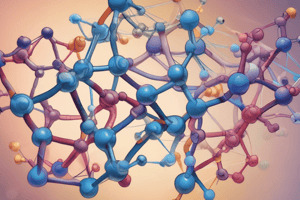Podcast
Questions and Answers
Explain the process by which proteins form from amino acids, including the type of reaction involved and the resulting bond formed.
Explain the process by which proteins form from amino acids, including the type of reaction involved and the resulting bond formed.
Proteins form by amino acids undergoing condensation reactions, in which the amino acids lose one water molecule per reaction in order to attach to one another with a peptide bond.
What are the driving forces behind the folding of proteins into specific spatial conformations?
What are the driving forces behind the folding of proteins into specific spatial conformations?
Proteins fold into specific spatial conformations driven by a number of non-covalent interactions, such as hydrogen bonding, ionic interactions, Van der Waals forces, and hydrophobic packing.
Why is it often necessary to determine the three-dimensional structure of proteins in order to understand their functions at a molecular level?
Why is it often necessary to determine the three-dimensional structure of proteins in order to understand their functions at a molecular level?
To understand the functions of proteins at a molecular level, it is often necessary to determine their three-dimensional structure, as this provides insight into their biological function.
What techniques are employed in structural biology to determine the structure of proteins?
What techniques are employed in structural biology to determine the structure of proteins?
Explain the concept of 'superdomain' in the context of protein structure and evolution.
Explain the concept of 'superdomain' in the context of protein structure and evolution.
What do structural and sequence motifs refer to in the context of protein structure?
What do structural and sequence motifs refer to in the context of protein structure?
Define supersecondary structure and provide an example of a specific combination of secondary structure elements.
Define supersecondary structure and provide an example of a specific combination of secondary structure elements.
What is meant by protein fold and how is it related to protein topology?
What is meant by protein fold and how is it related to protein topology?
Explain the concept of protein dynamics and its relevance to protein function.
Explain the concept of protein dynamics and its relevance to protein function.
Provide examples of nanoscale biological machines within cells and their functions.
Provide examples of nanoscale biological machines within cells and their functions.
What are intrinsically disordered proteins, and how do they differ from relatively stable tertiary structures?
What are intrinsically disordered proteins, and how do they differ from relatively stable tertiary structures?
Explain the role of flexible linkers in protein domain dynamics and allostery.
Explain the role of flexible linkers in protein domain dynamics and allostery.
Explain the four levels of protein structure.
Explain the four levels of protein structure.
What is the primary structure of a protein?
What is the primary structure of a protein?
What are the two types of secondary structure in proteins?
What are the two types of secondary structure in proteins?
What is the tertiary structure of a protein?
What is the tertiary structure of a protein?
What does the quaternary structure of a protein involve?
What does the quaternary structure of a protein involve?
What are some examples of quaternary structures?
What are some examples of quaternary structures?
What are some structural units of proteins?
What are some structural units of proteins?
What are structural domains in proteins?
What are structural domains in proteins?
Can domains be swapped between proteins? If so, what can they create?
Can domains be swapped between proteins? If so, what can they create?
What determines the sequence of a protein?
What determines the sequence of a protein?
Flashcards are hidden until you start studying
Study Notes
Protein Structure and Function
- Proteins are composed of actin molecules forming microfilaments
- Proteins undergo reversible conformational changes for biological function
- Protein structure has four levels: primary, secondary, tertiary, and quaternary
- Primary structure is the sequence of amino acids in a polypeptide chain
- Secondary structure includes α-helix and β-sheets formed by hydrogen bonds
- Tertiary structure is the three-dimensional folding of a single protein molecule
- Quaternary structure involves the aggregation of multiple polypeptide chains
- Quaternary structures can form dimers, trimers, tetramers, or pentamers
- Proteins consist of structural units like domains, motifs, and folds
- Structural domains are self-stabilizing elements that often fold independently
- Domains can be swapped between proteins to create chimera proteins
- The sequence of a protein is determined by the corresponding gene and unique to that protein, defining its structure and function
Studying That Suits You
Use AI to generate personalized quizzes and flashcards to suit your learning preferences.




